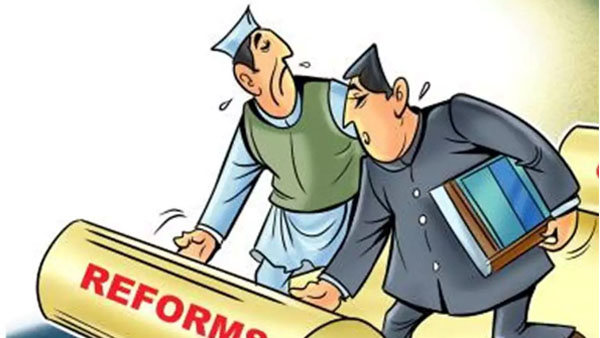By Dipak Kurmi
As 2024 dawns, India finds itself standing at an economic crossroads, with both formidable challenges and potential opportunities shaping the year ahead. The landscape is marked by a delicate balancing act — both domestically and internationally — as the nation attempts to weather the geopolitical storms brewing on the global stage while navigating internal economic pressures. The return of Donald Trump to the US presidency brings with it a host of uncertainties, particularly regarding trade policy and its ripple effects on the global economy, including India. On the domestic front, the focus will be on the new leadership at the Reserve Bank of India (RBI) under Sanjay Malhotra, and the government’s capacity to press ahead with crucial economic reforms.
The coming months are expected to bring economic tests of various magnitudes. In the international arena, the specter of geopolitical instability looms large, with ongoing conflicts such as the Russia-Ukraine war and the Gaza conflict showing no signs of abating. The implications of these crises are far-reaching. While the Gaza conflict has not yet escalated to the degree that it has significantly impacted global economic dynamics, its potential to trigger wider regional instability remains high. The involvement of countries like Lebanon and Iran could disrupt oil production and availability in the Middle East, causing a spike in global oil prices — a scenario that would certainly affect India’s oil import bill and exacerbate inflationary pressures at home.
Currently, the global oil market is experiencing a period of relative stability, with benchmark Brent crude prices hovering around $72 to $74 per barrel. However, should the geopolitical situation in West Asia deteriorate further, oil prices could surge, compounding India’s fiscal challenges. The country, already burdened by its oil import dependence, would face not only a rise in the oil import bill but also inflationary spikes, which could stall the economic recovery and impede growth.
Domestically, India’s economic outlook is weighed down by slowing growth, as evidenced by the disappointing GDP figures for the second quarter of the fiscal year. Growth had dipped to a seven-month low of 4.5% between July and September 2023, with projections for the full year likely falling short of the 8.2% growth seen in 2023-24. While some optimism remains due to signs of reviving consumption and expectations of a pickup in the third quarter, the overall economic momentum remains fragile. This slowing growth, combined with inflationary pressures and the growing risk of external shocks, poses a daunting challenge for policymakers.
A key concern for India in 2024 is the potential impact of Donald Trump’s trade policies. Although the specific contours of his administration’s approach to tariffs and international trade remain uncertain, Trump has already signaled a preference for a tough stance on trade relations, particularly with China. His call for “reciprocity” in trade agreements could have significant consequences for India, which has increasingly relied on exports to the US market. Trump has openly criticized India’s high tariff barriers, describing the country as a “big abuser of tariffs” and warning that such policies would invite retaliatory measures. India’s growing tariff barriers over the past two years may now come under scrutiny, and the fear is that if these tariffs remain high, Indian goods could lose competitiveness in the crucial American market.
While easing protectionist tendencies globally could benefit India’s exports, it remains unclear whether the US will offer India a competitive edge over other emerging economies, especially China. The shape of the Trump administration’s final trade policy will be crucial in determining the extent to which India can expand its footprint in the US market.
Against this backdrop of global uncertainty, much will depend on India’s internal policies and the government’s ability to navigate both inflation and growth. The new RBI Governor, Sanjay Malhotra, will have a critical role in determining the course of India’s monetary policy in 2024. Inflation has been moderating, with the Consumer Price Index (CPI) cooling to 5.48% in November 2023, and food inflation showing signs of easing. This moderation in inflation has raised hopes for a potential rate cut by the RBI, which could provide a much-needed boost to investment and economic growth. However, the RBI will have to balance this with its commitment to controlling inflation, ensuring that any monetary policy decisions made are both forward-looking and in line with broader economic stability goals.
At the same time, the Modi government will face pressure to deliver bold fiscal measures in its second Budget of its third term, which is set to be presented in early 2024. The need for deepening reforms is pressing, particularly when it comes to dismantling the regulatory barriers that impede growth. The country’s cumbersome regulatory framework, particularly in areas like labor laws and land acquisition, remains a significant deterrent to both foreign and domestic investments. These obstacles must be addressed through comprehensive reforms to create a more business-friendly environment. The upcoming Budget presents an opportunity for the government to demonstrate its commitment to removing these bottlenecks and providing the private sector with the space it needs to thrive.
The economic challenges ahead require more than just monetary and fiscal policy adjustments. They demand a structural transformation in how India approaches its growth strategy. The ongoing reforms of the early 1990s that liberalized the economy have paid dividends in the form of rapid economic growth and global integration, but it is now time for a second wave of reforms — ones that tackle the deep-rooted inefficiencies in the system. A bold, comprehensive set of measures is needed to streamline the regulatory environment, increase transparency, and make it easier to do business across the country. These reforms will be essential if India is to maintain its status as the fastest-growing major economy and meet the ambitious growth targets that have been set for the coming years.
The passing of several key figures in India’s economic landscape — including the late former Prime Minister Manmohan Singh, and industrialists Ratan Tata and Osamu Suzuki — underscores the importance of visionary leadership in shaping the country’s future. These leaders were pivotal in propelling India into the global economic mainstream, but as the country looks ahead to 2025 and beyond, new leadership must take the reins and continue pushing for economic growth and global competitiveness.
India’s journey towards higher growth rates, possibly in the range of 8-9%, hinges on the successful implementation of these reforms and the ability of policymakers to address both internal and external challenges. The 2025-26 Budget will be a critical juncture for the government to set the tone for this next phase of economic development. The coming year offers a unique opportunity to push forward with bold, transformative policies that can ensure sustainable, inclusive growth for years to come. Only through decisive action can India hope to remain a global economic leader in the decades ahead.
While India faces an array of challenges — from geopolitical instability and global trade tensions to domestic economic slowdowns — it also stands at a unique moment in time. The choices made in 2024 will reverberate across the coming decades, shaping the trajectory of India’s economic rise. With bold leadership, strategic reforms, and a keen eye on global dynamics, India can overcome these obstacles and continue its journey towards becoming a truly global economic powerhouse.
(the writer can be reached at dipakkurmiglpltd@gmail.com)




